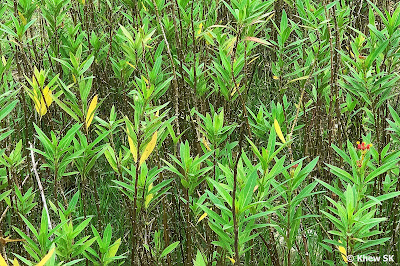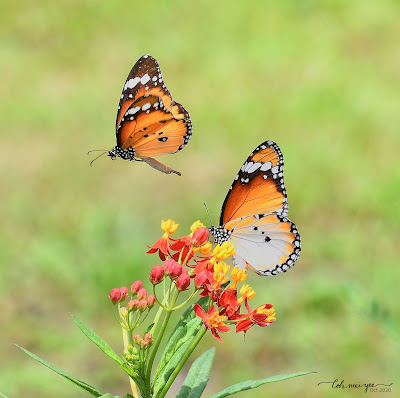The Blood Flower (Asclepias curassavica)
An orange-hindwinged form-chrysippus Plain Tiger feeding on the flowers of the Blood Flower
Our 18th feature plant in the series of butterflies' favourite nectaring plants is a non-native "milkweed" that comes from tropical South America. This plant is better known locally in Singapore as one of two of the caterpillar host plants of the Plain Tiger (Danaus chrysippus chrysippus). The Blood Flower (or Scarlet Milkweed) is sometimes cultivated in butterfly gardens to attract and support the conservation of the Plain Tiger.
The Blood Flower is a lactiferous plant from the dogbane family, Apocynaceae. When parts of the leaves or stems are snapped or damaged, a whitish milky fluid is excreted. This milky sap is poisonous and can cause skin irritation in sensitive people. The caterpillar of the Plain Tiger sequester the toxic constituents of the plant to make it distasteful to predators like birds. The adult butterfly is also distasteful, as are the other species in the Danainae sub-family, and displays aposematic colouration.
A lush patch of Blood Flower with healthy blooms
The Blood Flower is also known by several common names, one of which is "Scarlet Milkweed". This is a sign at the Blood Flower patch at Gardens by the Bay
The plant is an evergreen erect herbaceous perennial, and grows up to 1.2m tall. It is usually cultivated for its attractive red and orange flowers. There are also all-yellow flowered cultivars. The plant has a small spread and is never considered bushy. It is best cultivated in plant beds and as feature plants in landscaped gardens. For a better visual effect, 20 or more plants should be planted together.
Young Blood Flower plants grown together in a butterfly garden patch
The Blood Flower is considered a low shrub and sometimes cultivated in pots too. It flowers throughout the year and usually does best in open areas in full sunshine. It is an exotic and it does not grow naturally in Singapore and where it grows, it has usually been cultivated. Its region of origin is Tropical South America. Its presence in Singapore is limited to cultivated parks and gardens, usually grown as an accent shrub for its colourful flowers in combination with other flowering plants.
A Plain Tiger caterpillar munching on the flower of the Blood Flower
Plant Biodata:
Family: Apocynaceae
Genus : Asclepias
Species : curassavica
Synonyms : Asclepias bicolor, Asclepias margaritacea, Asclepias aurantiaca, Asclepias curassavica var. concolor, Asclepias cubensis, Asclepias nivea var. curassavica
Country/Region of Origin : Central and Northern parts of South America, Mexico, Curacao
English Common Names : Blood Flower, Cancerillo, Sunset Flower, Pleurisy Root, Cotton Bush, Red-head, Indian Root, Swallow Wort, Scarlet Milkweed, Matal, Bastard Pecacuanha, Milkweed, Silkweed, Mexican Butterfly Weed
Other Local Names : Kakatundi, Madhar (Hindi),马利筋, 连生桂子花
Some butterflies love the attractive red and orange-yellow flowers of the Blood Flower
As a tropical plant, the Blood Flower blooms continuously throughout the year. It is relatively heat tolerant and and grows best in full sun with regular moisture. As the plant flowers and grows older, it is likely to look lanky and unattractive. It is then time to cut it down and let it sprout new shoots to regenerate growth again. The plant is susceptible to sucking insects like aphids and mealy bugs and is often attacked by these pests, particularly on the young shoots and growth of the plant, stunting its growth and turning the leaves yellow.
The green lanceolate leaves of the Blood Flower plant
The leaves of the Blood Flower are simple, opposite, shortly petioled, lanceolate to narrow-elliptic in shape, acuminate and measure 6 to 15 cm long and 6 to 25 cm wide. The base is narrowed. The leaves are green, sometimes with a white mid-rib. The stems are smooth, round and dull green permeated with red when young, turning to brownish-grey when matured.
Buds of the Blood Flower. Note the aphids feeding on the stems
A close up shot of the flower of the Blood Flower
Flowers of the Blood Flower plant in various stages of maturity
The all-yellow flowers of a rarer cultivar of the Blood Flower
The flowers are perfect, radially symmetrical or irregularly shaped, bright red or orange with yellow centres, and measure approximately 12.5 mm. There are five sepals, deeply divided, reflexed and green. There are five petals which are linear with base united into a fused corolla. The corolla lobes are red, reflexed, oblong and approximately 8 mm long. The corona is hood-shaped with inwardly curved horns. There are five stamens. Anthers have two pollen sacs. The style filaments are united with pistils which have two carpels.
A young follicle (seed pod) of the Blood Flower (left) ; and the ripened pod with the Blood Flower seeds all ready to be disperse by the wind
The fruit is a pair of dry dehiscent, spindle-shaped follicles, measuring 5 to 15 cm long. Seed pods are light green and elongated, with approximately 70 to 80 seeds and split lengthways on one side upon maturity. Seeds are ovate and flattened, brown, 6 to 7 mm long, and have a narrow wing completely encircling the margin. Each seed is topped with a coma comprised of silky white hairs, 2 to 3 cm long, that assist in dispersal by wind.
Two forms of the Plain Tiger
A Common Mime feeding on the flower of the Blood Flower
Where the Blood Flower is cultivated, some of the common urban butterflies visit the flowers for its nectar. Amongst the Papilionidae, I have only seen the Common Mime (Papilio clytia clytia) feeding at its flowers. Perhaps the other Swallowtails and Birdwings prefer other nectaring sources than the Blood Flower, but it is also possible that the Common Mime, being a mimic of the Blue and Dark Glassy Tigers, is able to fool predators into avoiding it whilst feeding on this flowering plant with its more distasteful friends.
The Danainae are often seen on the Blood Flower as a nectaring source, and we have recorded the Common Tiger, Plain Tiger, Black Veined Tiger, Blue Glassy Tiger and Dark Glassy Tiger feeding at the flowers of this plant. Further observations are needed to see if other species of the Danainae also feed on this nectaring plant.
Three Pansies and a Tawny Coster on the flowers of the Blood Flower
A female Plain Tiger ovipositing on the leaf of a Blood Flower
Besides being one of the caterpillar host plants of the Plain Tiger, the flowers of the Blood Flower are also a nectaring source for urban butterflies. This plant should be in the landscaping palette of a butterfly garden's designer, as it is certainly a butterfly-attracting plant that is visually attractive and easy to cultivate.
Text by Khew SK : Photos by Sunny Chir, Khew SK, Loh MY and Loke PF.































